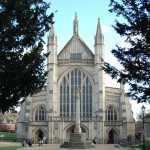WINCHESTER CATHEDRAL
Winchester Cathedral is a cathedral church and one of the biggest temples of Europe. It is located in Winchester, Hampshire County, Great Britain. It is dedicated to the Holy Trinity, Apostles Peter and Paul and to St. Swithun. It is the main temple of Winchester diocese and the seat of the Bishop of Winchester.
The first Christian stone temple erected on the site of the present one was a cathedral, which later became known as Old Minster (old cathedral). There is a tradition, according to which it was founded in II century by Lucius, mythical king of Britons, but it is no more than a legend. Actually, construction of the cathedral was initiated by Cenwalh, king of Wessex, and it was completed by 648. In 660, the cathedral became the main temple of the diocese.
Throughout the next century it was gradually added on — for example, a tower dedicated to St. Martin was erected. In 862, Swithun, canonized Bishop of Winchester, was buried on the territory of Old Minster. In 901, new church called New Minster (new cathedral) was built right next to the old cathedral. In the end of X century, at the time of Bishop of Winchester Aethelwold’s monastic reforms, Old Mister was almost completely rebuilt and became part of a Benedictine monastery complex. After Aethelwold’s death in 984, his successor Alphege continued reconstructing of the cathedral.
Many rulers of Wessex and England were buried on the territory of Old Minster — Cynegils (AD 643), Cenwalh (AD 674), Cynewulf (AD 786), Egbert (AD 839, and in 828, the ceremony of his coronation was held in the cathedral), Aethelwulf (AD 858), Alfred the Great (temporarily in AD 899), and Canute the Great (1035).
After the Norman Conquest, bishop Wakelin who was promoted by Normans was given the responsibility to build a new church on the site of Old Minster in Romanesque style. The temple was demolished to the ground and construction of the new cathedral began — in particular, new crypts and transepts were built — to continue from 1079 to 1093 AD. In its new appearance the cathedral remained one of the most important religious centers of the country. On August 11 of 1100, king William II (son of William the Conqueror), who was killed while hunting on August 2, was buried in its tower, which collapsed shortly after that. In 1108, a new tower was laid; its construction lasted till 1120. In general, the cathedral was many times added on and refurbished: for example, in 1394, its nave was reconstructed. In 1905-1912, major restoration works were carried out in the cathedral. In particular, through the efforts of famous British deep water diver William Walker southern and eastern sides of foundation buried under water were strengthened. For saving the cathedral from complete destruction Walker was rewarded and became a Member of Victorian Order.
Following ceremonies were held in Winchester Cathedral:
* 1172 – Coronation of Henry the Young and his spouse Margaret of France
* 1194 – Second coronation of Richard the Lion Heart
* 1403 – Wedding of Henry IV and Joan of Navarre
* 1554 – Wedding of Mary I and Philip II
Mainly the tourists are attracted to the tomb of lady writer Jane Austin who passed away in 1817 in Winchester and was buried in the northern chantry of the nave. The cathedral gained more popularity after it was mentioned in a series of novels “Chronicles of Barsetshire” written by Anthony Trollope, as well as from the fact that in 2005 in the northern transept of the cathedral (imitating the Vatican) “The Da Vinci Code” movie episodes were shot based on the eponymous bestseller of Dan Brown. Theophany Chapel is adorned with stained glass windows done according to the designs of Edward Burne-Jones, one of the prominent masters among Pre-Raphaelites, at the factory of William Morris.
http://www.winchester-cathedral.org.uk/
http://www.earlybritishkingdoms.com/adversaries/archaeology/oldminster.html

